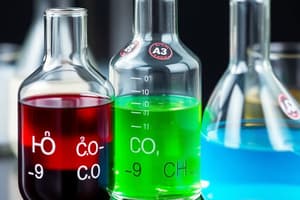Podcast
Questions and Answers
What is produced when an acid reacts with a metal?
What is produced when an acid reacts with a metal?
- Hydrogen gas and oxygen
- Water and carbon dioxide
- Salt and water
- Salt and hydrogen gas (correct)
Which pH value corresponds to a neutral solution?
Which pH value corresponds to a neutral solution?
- 10
- 14
- 7 (correct)
- 4
What is a limitation of using a universal indicator?
What is a limitation of using a universal indicator?
- It requires no calibration.
- It doesn't work on dark colored solutions. (correct)
- It gives highly accurate measurements.
- It can be reused multiple times.
Which of the following acids is commonly used in car batteries?
Which of the following acids is commonly used in car batteries?
What happens when blue litmus paper is placed in an acidic solution?
What happens when blue litmus paper is placed in an acidic solution?
What is produced when an acid reacts with a metal during neutralization?
What is produced when an acid reacts with a metal during neutralization?
What is the first action to take if acid gets into the eyes?
What is the first action to take if acid gets into the eyes?
Which of the following is a product of neutralization between hydrochloric acid and calcium carbonate?
Which of the following is a product of neutralization between hydrochloric acid and calcium carbonate?
What safety equipment should be worn when handling acids and alkalis?
What safety equipment should be worn when handling acids and alkalis?
What indicates the presence of hydrogen when a burning splint is inserted into a test tube containing dilute nitric acid and zinc?
What indicates the presence of hydrogen when a burning splint is inserted into a test tube containing dilute nitric acid and zinc?
What happens to lime water when carbon dioxide is bubbled through it?
What happens to lime water when carbon dioxide is bubbled through it?
What should be done with used solutions after an experiment involving acids or alkalis?
What should be done with used solutions after an experiment involving acids or alkalis?
Which statement is true regarding bee stings and mosquito bites?
Which statement is true regarding bee stings and mosquito bites?
Flashcards
Neutralization
Neutralization
A chemical reaction where an acid and a base react to form salt and water, releasing heat.
Alkali
Alkali
A substance that can neutralize acids, typically having a pH greater than 7.
Acid
Acid
A substance that can donate a proton (H+ ion), typically having a pH less than 7.
Acid + Metal Reaction
Acid + Metal Reaction
Signup and view all the flashcards
Acid + Carbonate Reaction
Acid + Carbonate Reaction
Signup and view all the flashcards
Carbon Dioxide (CO2)
Carbon Dioxide (CO2)
Signup and view all the flashcards
Base
Base
Signup and view all the flashcards
Salt
Salt
Signup and view all the flashcards
pH scale
pH scale
Signup and view all the flashcards
Litmus paper
Litmus paper
Signup and view all the flashcards
pH meter
pH meter
Signup and view all the flashcards
Study Notes
Acid-Base Reactions
- Acids and Alkalis: Acid + Alkali → Salt + Water
- Acid + Metal: Acid + Metal → Salt + Hydrogen
- Acid + Carbonate: Acid + Carbonate → Salt + Water + Carbon Dioxide
Indicators
- Litmus: Red in acid, blue in alkali
- Universal Indicator: Colours change across a range, indicating pH
- pH Meter: Measures pH accurately
Flame Tests
- Oxygen: Relights a glowing splint
- Carbon Dioxide: Extinguishes a glowing splint, does not relight
Action on Different Materials
- Skin: Immediately wash affected area with water for at least 10 minutes
- Eyes: Immediately wash eyes with eye wash bottle for 10 minutes
- Clothes: Carefully remove affected clothing and avoid contact with other clothing
- Zinc: Can be corroded by both acids and alkalis
- Limestone: Dissolves in acids, releasing CO2
- Limewater: No change with CO2
Safety Procedures
- Gloves, Lab coat, Goggles: Wear to handle acids and alkalis
- Hazard symbols: Read hazard symbols to take necessary precautions
- Waste Disposal: Pour used solutions into waste bottles, do not pour into sink, wash hands thoroughly with soap
Studying That Suits You
Use AI to generate personalized quizzes and flashcards to suit your learning preferences.
Related Documents
Description
Test your knowledge on acid-base reactions, indicators, and safety procedures in chemistry. This quiz covers essential reactions and the behavior of acids and bases with various materials. Ensure you understand the fundamental principles and safety measures in handling these substances.




